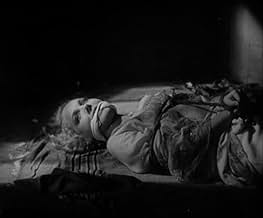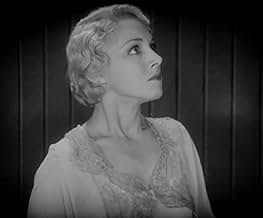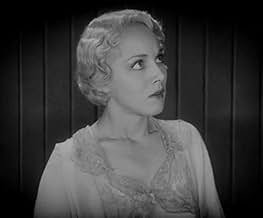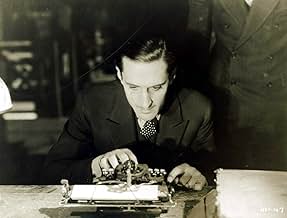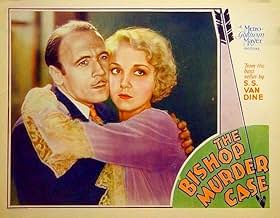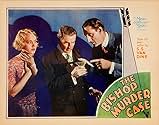Aggiungi una trama nella tua linguaWhen the body of a man nicknamed "Cock Robin" is found with an arrow in the heart on an archery range along with a chess bishop as a clue, Philo Vance investigates.When the body of a man nicknamed "Cock Robin" is found with an arrow in the heart on an archery range along with a chess bishop as a clue, Philo Vance investigates.When the body of a man nicknamed "Cock Robin" is found with an arrow in the heart on an archery range along with a chess bishop as a clue, Philo Vance investigates.
- Regia
- Sceneggiatura
- Star
Charles Quatermaine
- John Pardee
- (as Charles Quartermaine)
Sidney Bracey
- Pyne
- (as Sydney Bracey)
Richard Cramer
- Detective in Park
- (non citato nei titoli originali)
Frank Fanning
- Officer Manning
- (non citato nei titoli originali)
Marcia Mae Jones
- Hungry Child in Park
- (non citato nei titoli originali)
Broderick O'Farrell
- Dr. Van Pelt
- (non citato nei titoli originali)
Recensioni in evidenza
Good effort given the primitive technology. This very early talkie does not creak like most of them did, and you believe that the same team could have done much better only a few years later.
Check out the innovative scene of Hyams at the three-way mirror. Beautiful scene that directors even today should view for technique. There are several little skilled touches added to this film that make you realize that the only limitation on the talent was the primitive lower-than-low tech.
Rathbone and Hyams seem more modern than the movie and they definitely do not creak.
Must reluctantly give it a "5" because of old set-bound look of the film and the lack of music but it is rewarding if you can overlook such drawbacks.
Check out the innovative scene of Hyams at the three-way mirror. Beautiful scene that directors even today should view for technique. There are several little skilled touches added to this film that make you realize that the only limitation on the talent was the primitive lower-than-low tech.
Rathbone and Hyams seem more modern than the movie and they definitely do not creak.
Must reluctantly give it a "5" because of old set-bound look of the film and the lack of music but it is rewarding if you can overlook such drawbacks.
Basil Rathbone is a dashing, intense-looking Philo Vance in "The Bishop Murder Case," an early talkie that shows signs of the painful transition from silents. I actually had quite a bit of trouble with the sound. I saw it on television and had difficulty understanding what was being said at times.
The film, nevertheless, is very interesting, if only to see Rathbone, with those amazing eyes of his, in his pre-Sherlock Holmes days. His acting is excellent. It was also delightful to see Roland Young. Leila Hyams plays the professor's niece, and she was quite beautiful and effective. It has a good plot as well.
Parts of this film came off like a stage play, probably because some of the actors were still adjusting to film technique. And the sound was darned strange. In one of the outdoor scenes, the actors sounded as if they were speaking through megaphones. Nevertheless, Philo Vance fans should certainly enjoy it, as will others from a historical perspective.
The film, nevertheless, is very interesting, if only to see Rathbone, with those amazing eyes of his, in his pre-Sherlock Holmes days. His acting is excellent. It was also delightful to see Roland Young. Leila Hyams plays the professor's niece, and she was quite beautiful and effective. It has a good plot as well.
Parts of this film came off like a stage play, probably because some of the actors were still adjusting to film technique. And the sound was darned strange. In one of the outdoor scenes, the actors sounded as if they were speaking through megaphones. Nevertheless, Philo Vance fans should certainly enjoy it, as will others from a historical perspective.
I recently learned that Willard Huntington Wright aka S.S. Van Dine the author of the Philo Vance mysteries sold the various screen rights to his stories one at a time to the various studios who would pay for them. It's the reason that Paramount, MGM, Warner Brothers and later the B independent Producer's Releasing Corporation all had a hand in the series and we have so many Philos to compare styles with.
Basil Rathbone takes his turn at Philo and the Philo he creates isn't too much different from Sherlock Holmes. He's got no Watson to be his scribe and record his genius, but otherwise he's the same clever fellow who found out the secret of that hound of the Baskervilles, etc.
S.S. Van Dine did create a dumb flatfoot of a police sergeant Heath for Vance to constantly show up. At Paramount and later at Warner Brothers it was Eugene Palette, here we have James Donlon who even the maid puts down regularly. I'm not sure what Heath is there for because the District Attorney just calls in Vance for help when there's an interesting case.
Here we have the discovery of a dead body found on an archery field with an arrow through him. Of course the minute Vance gets there he deduces all is not as it appears.
I will say this, the murderer here was a surprise to me and even more important four people die in this film, but only the first murder was a planned one. The others happened because of some unforeseen circumstances our culprit didn't see coming.
That Philo, he's a regular Sherlock Holmes when it comes to solving these murders.
Basil Rathbone takes his turn at Philo and the Philo he creates isn't too much different from Sherlock Holmes. He's got no Watson to be his scribe and record his genius, but otherwise he's the same clever fellow who found out the secret of that hound of the Baskervilles, etc.
S.S. Van Dine did create a dumb flatfoot of a police sergeant Heath for Vance to constantly show up. At Paramount and later at Warner Brothers it was Eugene Palette, here we have James Donlon who even the maid puts down regularly. I'm not sure what Heath is there for because the District Attorney just calls in Vance for help when there's an interesting case.
Here we have the discovery of a dead body found on an archery field with an arrow through him. Of course the minute Vance gets there he deduces all is not as it appears.
I will say this, the murderer here was a surprise to me and even more important four people die in this film, but only the first murder was a planned one. The others happened because of some unforeseen circumstances our culprit didn't see coming.
That Philo, he's a regular Sherlock Holmes when it comes to solving these murders.
Basil Rathbone makes a good Philo Vance in this murder mystery involving nursery rhymes. It's a forerunner of his great portrayal of Sherlock Holmes later in his career. He even uses his powers of observation to deduce that the sergeant (James Donlan) wrote a check that afternoon, soon has a date with a woman, etc., much the same way Holmes did, continually astounding Dr. Watson. But the comedy Donlan provides - and he's the only comic relief in the film - is on an infantile level. When he sees Rathbone for the first time, he says "I've solved this case, Mr. Vance. It's a murder." The script is really less than lacking in the humor department. On the other hand, all the other characters do not behave as stupid, and are believable in their roles. I loved the interesting faces and characterizations of George F. Marion and Charles Quartermaine. And there is one lovely photographed scene when Leila Hyams is sitting at a desk with a triple mirror when a sinister hand opens the door. You see her terrified face from four different angles at once, and it's a stunning effect.
This is the type of mystery that is virtually impossible to figure out. You have to go with the flow and watch the events unfold until the end when they are explained. There are lots of red herrings along the way, so I found myself switching from one suspect to another as the probable murderer. It was fun.
This is the type of mystery that is virtually impossible to figure out. You have to go with the flow and watch the events unfold until the end when they are explained. There are lots of red herrings along the way, so I found myself switching from one suspect to another as the probable murderer. It was fun.
"The Bishop Murder Case" is one of the best in the Philo Vance film series. The mystery seems a bit silly at first when children's nursery rhymes are used by the perpetrator of the crimes to publicize his murders, not unlike methods used by present-day serial killers. But once the plot unfolds the nursery rhyme angle makes complete sense. The Bishop is a key figure in solving the mystery as the title indicates. So keep your eyes focused on that clue. I won't say any more except to add that this is a complex mystery.
Basil Rathbone is second only to William Powell in breathing life into S.S. Van Dine's famous private investigator. It's obvious from this performance why Rathbone was chosen at the end of the decade to play Sherlock Holmes. The other actor who shines in this movie is Roland Young. Though much of the acting hearkens back to the silent era which was coming to an end, Rathbone and Young seem modern in their approach. From playing on stage and in silent pictures, actors were used to wild exaggerations and outlandish gesticulations which were no longer needed now that movies could talk. Several of the characters in "The Bishop Murder Case" have not yet adjusted to working with sound. Not so Rathbone and Young.
Another early talky distraction for modern viewers is the absence of music for dramatic effect. Since live music was used to accentuate the silent screen action and mood, it seems strange that music was not immediately utilized for the same purposes on the talky screen. Producers were misinformed that music coming from nowhere would puzzle and confuse the audience. So it took a few years for Hollywood to rid itself of this misconception. The decision not to use music plus fairly primitive sound effects (the viewer will readily recognize the sound of thunder as the sound of huge sheets of metal being snapped)take away from the overall effects of this otherwise clever and well-written murder mystery.
Basil Rathbone is second only to William Powell in breathing life into S.S. Van Dine's famous private investigator. It's obvious from this performance why Rathbone was chosen at the end of the decade to play Sherlock Holmes. The other actor who shines in this movie is Roland Young. Though much of the acting hearkens back to the silent era which was coming to an end, Rathbone and Young seem modern in their approach. From playing on stage and in silent pictures, actors were used to wild exaggerations and outlandish gesticulations which were no longer needed now that movies could talk. Several of the characters in "The Bishop Murder Case" have not yet adjusted to working with sound. Not so Rathbone and Young.
Another early talky distraction for modern viewers is the absence of music for dramatic effect. Since live music was used to accentuate the silent screen action and mood, it seems strange that music was not immediately utilized for the same purposes on the talky screen. Producers were misinformed that music coming from nowhere would puzzle and confuse the audience. So it took a few years for Hollywood to rid itself of this misconception. The decision not to use music plus fairly primitive sound effects (the viewer will readily recognize the sound of thunder as the sound of huge sheets of metal being snapped)take away from the overall effects of this otherwise clever and well-written murder mystery.
Lo sapevi?
- QuizSeveral times Sigurd Arnesson (Roland Young) sarcastically calls Philo Vance (Basil Rathbone) "Sherlock Holmes". Nine years later, Rathbone would take the role of Holmes in Il mastino dei Baskerville (1939) (and 14 sequels), and it became his iconic role.
- BlooperWhen Vance and fellow detectives investigate the body of Robin, who has been shot with an arrow, the angle of the arrow changes. Sometimes it's straight up out of the body, other times it's at almost a 45 degree angle.
- Citazioni
Philo Vance: [to Heath] Sergeant, you're much too trusting for this deceitful world. If everything happened as easy as that, life would be very simple and very dull.
- ConnessioniFollowed by The Benson Murder Case (1930)
- Colonne sonoreWaltz of the Flowers
(1891-2) (uncredited)
from "The Nutcracker Suite, Op.71a"
Written by Pyotr Ilyich Tchaikovsky
Played on piano by Basil Rathbone
I più visti
Accedi per valutare e creare un elenco di titoli salvati per ottenere consigli personalizzati
- How long is The Bishop Murder Case?Powered by Alexa
Dettagli
- Data di uscita
- Paese di origine
- Lingua
- Celebre anche come
- Дело об убийстве епископа
- Luoghi delle riprese
- Grant's Tomb, Riverside Drive, New York, New York, Stati Uniti(Vance's car drives past in a second unit shot)
- Azienda produttrice
- Vedi altri crediti dell’azienda su IMDbPro
- Tempo di esecuzione1 ora 28 minuti
- Colore
Contribuisci a questa pagina
Suggerisci una modifica o aggiungi i contenuti mancanti

Divario superiore
What is the Spanish language plot outline for The Bishop Murder Case (1929)?
Rispondi
